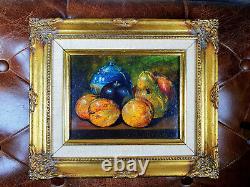
- Home
- Artist
- André Poirson (4)
- Anonymous (5)
- Bouquier (3)
- Claude Revardeau (2)
- Clery Pierpont (2)
- Contemporary (5)
- Courtine (2)
- Felicia Butel (2)
- Henri Royet (2)
- Illegible (2)
- Jean-paul Ulysse (4)
- Maurice Barle (3)
- Maurice Bismuth (2)
- Pierre Jaillet (2)
- Renoir (3)
- René Lévy (2)
- Siarnowski (2)
- Unknown (3)
- Unsigned (4)
- Werner Gilles (2)
- Other (4948)
- Characteristics
- Boxed (2)
- Framed (23)
- Framed, On Canvas (11)
- Framed, On Panel (2)
- Framed, On Wood (37)
- Framed, Signed (4)
- Miniature (3)
- On Canvas (8)
- On Panel (25)
- On Wood (128)
- On Wood, On Canvas (6)
- On Wood, On Panel (15)
- On Wood, Signed (3)
- Signed (13)
- Signed, On Canvas (13)
- Signed, On Panel (10)
- Signed, On Wood (58)
- Other (4643)
- Height
- Style
- 1900 Ou Avant (6)
- 1910-1920 (6)
- 1920-1930 (26)
- 1920-1940 (9)
- 20th Century Style (15)
- Art Deco (6)
- Contemporary (7)
- Non-spécifié (59)
- Not Specified (18)
- Unspecified (52)
- École De Barbizon (12)
- 1900 (12)
- 1920 (10)
- 1930 (16)
- 1930-1940 (17)
- 1940 (26)
- 1940-1960 (238)
- 1970 (46)
- 1980 (23)
- 1990 (12)
- Other (4388)
- Type
- Width
Tableau signed Still Life, oil on wood.




Tableau entitled Still Life, oil on wood, 18 x 14 cm. Frame: 27.5 x 23.5 cm. We are presented with a still life, or "motionless nature," "nature posing as a model," preferred terms by Dutch painters. This painting is a representation of life that highlights a duality within the work.
Indeed, the artist establishes this dichotomy by contrasting fruits with orange hues that seem to unite around green bursts, symbolizing hope, and contradicting the left side of the painting. The pear itself, although green, presents the ochre tones of the apricots and the fruit in the background. The pear unifies these food items with the background of the right part of the work, marked by green tones that oppose the dark portion of the painting. The fly present on the oblong fruit, whose color varies from green to orange, seems to want to leave the shimmering part and join the fruit that seems to symbolize death within the work through its darkness and the seduction it exerts on the stout-shaped insect. The aesthetics of trompe-l'oeil and its illusionistic effects construct a sensual art through the vase, this large porcelain vase that seems, through its colors, to be from the Far East and invites exoticism into the artist's art.
So if death can be considered seductive because it is surrounded by mysteries and thus present an exotic character portrayed by the vase, the moral resonance that we will remember from this work is the reflection of the pear in the drawing of the apple, which reveals, according to the artist, that life belongs to death and that it leaves behind fruits, perishable memories perhaps, but that others will have the joy of savoring before they too depart.
